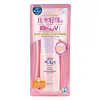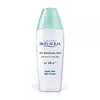What's inside
What's inside
 Key Ingredients
Key Ingredients

 Benefits
Benefits

 Concerns
Concerns

 Ingredients Side-by-side
Ingredients Side-by-side

Water
Skin ConditioningEthylhexyl Methoxycinnamate
UV AbsorberCyclopentasiloxane
EmollientTalc
AbrasiveIsododecane
EmollientAlcohol
AntimicrobialZinc Oxide
Cosmetic ColorantTitanium Dioxide
Cosmetic ColorantEthylhexyl Salicylate
UV AbsorberIsononyl Isononanoate
EmollientGlycerin
HumectantLauryl PEG-10 Tris(Trimethylsiloxy)Silylethyl Dimethicone
EmulsifyingPolymethyl Methacrylate
Diethylamino Hydroxybenzoyl Hexyl Benzoate
UV FilterTrimethylsiloxysilicate
EmollientBis-Ethylhexyloxyphenol Methoxyphenyl Triazine
Skin ConditioningCI 77163
Cosmetic ColorantEthylhexyl Hydroxystearate
EmollientTriethoxycaprylylsilane
Stearic Acid
CleansingAluminum Hydroxide
EmollientDiisostearyl Malate
EmollientCI 77492
Cosmetic ColorantDimethicone
EmollientTocopheryl Acetate
AntioxidantPolymethylsilsesquioxane
Methylparaben
PreservativeDisodium EDTA
Acrylates Crosspolymer
AbsorbentParfum
MaskingCI 77891
Cosmetic ColorantPEG/PPG-18/18 Dimethicone
EmulsifyingCI 77491
Cosmetic ColorantSodium Hyaluronate
HumectantCaprylic/Capric Triglyceride
MaskingCI 15850
Cosmetic ColorantPPG-3 Benzyl Ether Myristate
EmollientJuglans Regia Seed Extract
Skin ConditioningMagnesium Ascorbyl Phosphate
AntioxidantEctoin
Skin ConditioningLaminaria Ochroleuca Extract
Skin ConditioningPhenoxyethanol
PreservativeSodium Metabisulfite
AntioxidantWater, Ethylhexyl Methoxycinnamate, Cyclopentasiloxane, Talc, Isododecane, Alcohol, Zinc Oxide, Titanium Dioxide, Ethylhexyl Salicylate, Isononyl Isononanoate, Glycerin, Lauryl PEG-10 Tris(Trimethylsiloxy)Silylethyl Dimethicone, Polymethyl Methacrylate, Diethylamino Hydroxybenzoyl Hexyl Benzoate, Trimethylsiloxysilicate, Bis-Ethylhexyloxyphenol Methoxyphenyl Triazine, CI 77163, Ethylhexyl Hydroxystearate, Triethoxycaprylylsilane, Stearic Acid, Aluminum Hydroxide, Diisostearyl Malate, CI 77492, Dimethicone, Tocopheryl Acetate, Polymethylsilsesquioxane, Methylparaben, Disodium EDTA, Acrylates Crosspolymer, Parfum, CI 77891, PEG/PPG-18/18 Dimethicone, CI 77491, Sodium Hyaluronate, Caprylic/Capric Triglyceride, CI 15850, PPG-3 Benzyl Ether Myristate, Juglans Regia Seed Extract, Magnesium Ascorbyl Phosphate, Ectoin, Laminaria Ochroleuca Extract, Phenoxyethanol, Sodium Metabisulfite
Water
Skin ConditioningEthyl Methoxycinnamate
UV AbsorberMethylene Bis-Benzotriazolyl Tetramethylbutylphenol
UV FilterCyclopentasiloxane
EmollientGlycerin
HumectantEthylhexyl Triazone
UV AbsorberPolysorbate 60
EmulsifyingDiethylamino Hydroxybenzoyl Hexyl Benzoate
UV FilterBetaine
HumectantPhenoxyethanol
PreservativeAmmonium Acryloyldimethyltaurate/Vp Copolymer
Acrylates/C10-30 Alkyl Acrylate Crosspolymer
Emulsion StabilisingHydrogenated Lecithin
EmulsifyingTriethanolamine
BufferingPanthenol
Skin ConditioningDisodium EDTA
Methylparaben
PreservativePropylparaben
PreservativeSodium Hyaluronate
HumectantDipotassium Glycyrrhizate
HumectantSodium Acetylated Hyaluronate
HumectantArginine
MaskingHydrolyzed Collagen
EmollientTetrahexyldecyl Ascorbate
AntioxidantTocopheryl Acetate
AntioxidantWater, Ethyl Methoxycinnamate, Methylene Bis-Benzotriazolyl Tetramethylbutylphenol, Cyclopentasiloxane, Glycerin, Ethylhexyl Triazone, Polysorbate 60, Diethylamino Hydroxybenzoyl Hexyl Benzoate, Betaine, Phenoxyethanol, Ammonium Acryloyldimethyltaurate/Vp Copolymer, Acrylates/C10-30 Alkyl Acrylate Crosspolymer, Hydrogenated Lecithin, Triethanolamine, Panthenol, Disodium EDTA, Methylparaben, Propylparaben, Sodium Hyaluronate, Dipotassium Glycyrrhizate, Sodium Acetylated Hyaluronate, Arginine, Hydrolyzed Collagen, Tetrahexyldecyl Ascorbate, Tocopheryl Acetate
Ingredients Explained
These ingredients are found in both products.
Ingredients higher up in an ingredient list are typically present in a larger amount.
Cyclopentasiloxane, or D5, is a silicone used to improve texture of products and trap moisture.
D5 is considered lightweight and volatile. Volatile means it evaporates quickly after application. Once evaporated, D5 leaves a thin barrier that helps keep skin hydrated.
It is also an emollient. Emollients help soften the skin and prevent water loss. Silicones create a silky texture in products. D5 helps other ingredients become more spreadable.
Studies show D5 is safe to use in skincare products. We recommend speaking with a skincare professional if you have concerns.
Learn more about CyclopentasiloxaneDiethylamino Hydroxybenzoyl Hexyl Benzoate (DHHB) is a chemical UV-A absorber. It is formulated for high UVA protection (320-400 nm).
DHHB is well-liked for:
DHHB has been approved by the EU, Japan, Taiwan, and South America for use up to 10%. Unfortunately, it has not been approved for use in the US or Canada due to slow regulatory processes.
This ingredient is soluble in oils, fats, and lipids.
Learn more about Diethylamino Hydroxybenzoyl Hexyl BenzoateDisodium EDTA plays a role in making products more stable by aiding other preservatives.
It is a chelating agent, meaning it neutralizes metal ions that may be found in a product.
Disodium EDTA is a salt of edetic acid and is found to be safe in cosmetic ingredients.
Learn more about Disodium EDTAGlycerin is already naturally found in your skin. It helps moisturize and protect your skin.
A study from 2016 found glycerin to be more effective as a humectant than AHAs and hyaluronic acid.
As a humectant, it helps the skin stay hydrated by pulling moisture to your skin. The low molecular weight of glycerin allows it to pull moisture into the deeper layers of your skin.
Hydrated skin improves your skin barrier; Your skin barrier helps protect against irritants and bacteria.
Glycerin has also been found to have antimicrobial and antiviral properties. Due to these properties, glycerin is often used in wound and burn treatments.
In cosmetics, glycerin is usually derived from plants such as soybean or palm. However, it can also be sourced from animals, such as tallow or animal fat.
This ingredient is organic, colorless, odorless, and non-toxic.
Glycerin is the name for this ingredient in American English. British English uses Glycerol/Glycerine.
Learn more about GlycerinMethylparaben is a preservative and is a paraben. It is used to prevent the growth of fungus, mold, and other harmful bacteria. Parabens are chemicals used as preservatives in both cosmetics and food.
Methylparaben can be synthetically created. It can also be found naturally in some fruits, such as blueberries.
Oftentimes, Methylparaben is combined with other parabens to help increase the shelf life.
The safety of Methylparaben is currently being studied. While ongoing studies are looking into the safety of parabens, the results have been very mixed. Some studies have not found Methylparaben to be harmful.
Learn more about MethylparabenPhenoxyethanol is a preservative that has germicide, antimicrobial, and aromatic properties. Studies show that phenoxyethanol can prevent microbial growth. By itself, it has a scent that is similar to that of a rose.
It's often used in formulations along with Caprylyl Glycol to preserve the shelf life of products.
Sodium Hyaluronate is hyaluronic acid's salt form. It is commonly derived from the sodium salt of hyaluronic acid.
Like hyaluronic acid, it is great at holding water and acts as a humectant. This makes it a great skin hydrating ingredient.
Sodium Hyaluronate is naturally occurring in our bodies and is mostly found in eye fluid and joints.
These are some other common types of Hyaluronic Acid:
Learn more about Sodium HyaluronateTocopheryl Acetate is AKA Vitamin E. It is an antioxidant and protects your skin from free radicals. Free radicals damage the skin by breaking down collagen.
One study found using Tocopheryl Acetate with Vitamin C decreased the number of sunburned cells.
Tocopheryl Acetate is commonly found in both skincare and dietary supplements.
Learn more about Tocopheryl AcetateWater. It's the most common cosmetic ingredient of all. You'll usually see it at the top of ingredient lists, meaning that it makes up the largest part of the product.
So why is it so popular? Water most often acts as a solvent - this means that it helps dissolve other ingredients into the formulation.
You'll also recognize water as that liquid we all need to stay alive. If you see this, drink a glass of water. Stay hydrated!
Learn more about Water